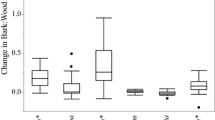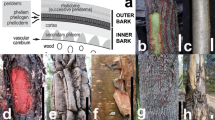Abstract
Tree bark characteristics influence epiphyte establishment and survival and consequently the way in which epiphytes are distributed on trees. Tree species with peeling bark have been reported as poor epiphyte hosts. We analyzed the distribution and seedling mortality of two Tillandsia species (Bromeliaceae) in relation to rate of bark peeling of Bursera fagaroides (Burseraceae). The highest peeling rate (0.12% per day) took place on the trunk and the lowest rate on twigs (0.04% per day; branches ≤2 cm in diameter). The highest proportion of Tillandsia plants appeared on twigs. The distributions of juvenile and adult plants on twigs were higher than those expected based on the distribution of first-year seedlings, suggesting that on twigs, survival could be greater than on trunks and branches, canopy areas where peeling is faster. On the trunk and branches, in contrast, the proportion of juveniles and adults were similar to or less than that expected for first-year seedlings. The main cause of mortality was peeling and the area of minor overall mortality was the trunk, suggesting that this area should be favored as the main distribution area for the Tillandsia species but is not. Our results show that the peeling rate of B. fagaroides depends on branch size and suggest that the Tillandsia distribution depends not only on peeling rate but also on seed dispersion. We suggest that to colonize B. fagaroides epiphytes would either have adaptations to counteract the peeling rate or should occur in the areas of lowest peeling rate located in the exterior crown of trees.


Similar content being viewed by others
References
Ackerman JD, Montalvo AM, Vera AM (1989) Epiphyte host specificity of Encyclia krugii, a Puerto Rican endemic orchid. Lindleyana 4:74–77
Ackerman JD, Sabat A, Zimmerman JK (1996) Seedling establishment in an epiphytic orchid: an experimental study of seed limitation. Oecologia 106:192–196
Bennett BC (1987) Spatial distribution of Catopsis and Guzmania (Bromeliaceae) in Southern Florida. Bull Torrey Bot Club 114:265–271
Benzing DH (1978a) Germination and early establishment of Tillandsia circinnata Schlecht (Bromeliaceae) on some of its host and other supports in the southern Florida. Selbyana 5:95–106
Benzing DH (1978b) The life history profile of Tillandsia circinnata (Bromeliaceae) and the rarity of extreme epiphytism among the angiosperms. Selbyana 2:325–337
Benzing DH (1981) The population dynamics of Tillandsia circinnata (Bromeliaceae): Cypress crown colonies in southern Florida. Selbyana 5:256–263
Benzing DH (1990) Vascular epiphytes. General biology and related biota. Cambridge University Press, Cambridge
Benzing DH, Davidson EA (1979) Oligotrophic Tillandsia circinnata Schlecht. (Bromeliaceae): an assessment of its patterns of mineral allocation and reproduction. Am J Bot 66:386–397
Brown DA (1990) El epifitismo en las selvas montanas del Parque Nacional “El Rey” Argentina: Composición florística y patrón de distribución. Rev Biol Trop 38:155–166
Callaway RM, Reihnart KO, Tucker SC, Pennings SC (2001) Effects of epiphytic lichens on host preference of the vascular epiphyte Tillandsia usneoides. Oikos 94:433–441
Callaway RM, Reihnart KO, Moore GW, Moore DJ, Pennings SC (2002) Epiphyte host preferences and host traits: mechanisms for species-specific interactions. Oecologia 132:221–230
Cascante-Marin A (2006) Establishment, reproduction and genetics of epiphytic bromeliad communities during premontane forest succession in Costa Rica. Ph.D. thesis, University of Amsterdam, Amsterdam
Castillo-Campos G, Medina-Abreo ME (2002) Árboles y arbustos de la reserva natural de La Mancha, Veracruz. Instituto de Ecología A. C., Xalapa
Castro-Hernández JC, Wolf JHD, García-Franco JG, González-Espinosa M (1997) The influence of humidity, nutrients and light on the establishment of the epiphytic bromeliad Tillandsia guatemalensis in the highlands of Chiapas, Mexico. Rev Biol Trop 47:763–773
Catling PM, Lefkovitch LP (1989) Associations of vascular epiphytes in a Guatemalan cloud forest. Biotropica 21:35–40
Flores-Palacios A, Ortiz-Pulido R (2005) Epiphyte orchid establishment on termite carton trails. Biotropica 37:457–461
Frei JK (1974) The ecology of epiphytic orchids in relation to their substrates. In: Szwat HH, Wemple J (eds) Proceedings of the Firths symposium on the scientific aspects of orchids, University of Detroit, Detroit, pp 46–62
Freiberg M (1996) Spatial distribution of vascular epiphytes on three emergent canopy trees in French Guiana. Biotropica 28:345–355
García-Franco JG (1996) Distribución de Epifitas Vasculares en Matorrales Costeros de Veracruz, México. Acta Bot Mex 37:1–9
García-Franco JG, Rico-Gray V (1988) Experiments on seed dispersal and deposition patterns of epiphytes. The case of Tillandsia deppeana Steudel (Bromeliaceae). Phytologia 65:73–78
Haberman SJ (1973) The analysis of residuals in cross-classified tables. Biometrics 29:205–220
Kiew R, Anthonysamy S (1987) A comparative study of vascular epiphytes in three epiphyte-rich habitats at Ulu Endau, Johore, Malaysia. Malay Nat J 41:303–315
Kress WJ (1986) The systematic distribution of vascular epiphytes: an update. Selbyana 9:2–22
Lyons B, Nadkarni NM, North MR (2000) Spatial distribution and succession of epiphytes on Tsuga heterophylla (western hemlock) in an old-grow Douglas-fir forest. Can J Bot 78:957–968
Madigosky SR (2004) Tropical microclimatic considerations. In: Lowman MD, Rinker HB (eds) Forest canopies. Elsevier Academic Press, London, pp 24–48
Martin CE (1994) Physiological ecology of the Bromeliaceae. Bot Rev 60:1–82
Martínez ML, García-Franco JG (2004) Plant–plant interactions in coastal dunes. In: Martínez ML, Pussy NP (eds) Coastal dunes, ecology and conservation. Spring-Verlag, Berlin, pp 205–220
Martínez-García E (1999) Estudio ecológico de las bromelias epífitas y sus hospederos en Selva Caducifolia de la Sierra de Huautla, Morelos. B.Sc. thesis. Facultad de Ciencias Biológicas, Universidad Autónoma del Estado de Morelos, Cuernavaca, Mexico
Mehltreter K, Flores-Palacios A, García-Franco JG (2005) Host preferences of low-trunk vascular epiphytes in a cloud forest of Veracruz, Mexico. J Trop Ecol 21:651–660
Mondragon D, Durán R, Ramírez I, Olmsted I (1999) Population dynamics of Tillandsia brachycaulos Schltdl. (Bromeliaceae) in Dzbilchaltun National Park, Yucatán. Selbyana 20:250–255
Mondragon D, Durán R, Ramírez I, Valverde T (2004) Temporal variation in the demography of the clonal epiphyte Tillandsia brachycaulos (Bromeliaceae) in the Yucatán Peninsula, Mexico. J Trop Ecol 20:189–200
Nadkarni NM (2000) Colonization of stripped branch surfaces by epiphytes in a lower montane cloud forest, Monteverde, Costa Rica. Biotropica 32:358–363
Rico-Gray V, García-Franco JG, Puch A, Sima P (1988) Composition and structure of a tropical dry forest in Yucatan, Mexico. Int J Ecol Environ Sci 14:21–29
Stevens GC (1987) Lianas as structural parasites: the Bursera simaruba example. Ecology 68:77–81
Talley SM, Setzer WN, Jackes BR (1996) Host associations of two adventitious-root-climbing vines in a north Queensland tropical rain forest. Biotropica 28:356–366
ter Steege H, Cornelissen JHC (1989) Distribution and ecology of vascular epiphytes in lowland rain forest of Guyana. Biotropica 21:331–339
Todzia C (1986) Growth habits, host tree species and density of hemiepiphytes on Barro Colorado island, Panama. Biotropica 18:22–27
Tremblay RL, Zimmerman JK, Lebrón L, Bayman P, Sastre I, Axelrod F, Alers-García L (1998) Host specificity and low reproductive success in the rare endemic Puerto Rican orchid Lepanthes caritensis. Biol Conserv 85:297–304
Valencia-Díaz S (1995) Estudio cuantitativo de la vegetación perenne asociada al pitayo (Stenocereus queretaroensis (Web.) Buxb.) en la cuenca de Sayula, Jalisco. B.Sc. thesis. Facultad de Biología, Universidad de Guadalajara, Guadalajara, Jalisco
Winkler M (2005) Population dynamics of epiphytes related to canopy structure in a Mexican humid montane forest. Ph.D. thesis, University of Natural Resources and Applied Life Sciences, Vienna
Zar JH (1996) Biostatistical analysis. Prentice-Hall, New Jersey
Zimmerman JK, Olmsted IC (1992) Host tree utilization by vascular epiphytes in a seasonally inundated forest (Tintal) in México. Biotropica 24:402–427
Zotz G (1997) Substrate use of three epiphytic bromeliads. Ecography 20:264–270
Zotz G (2004) Growth and survival of the early stages of the heteroblastic bromeliad Vriesia sanguinolenta. Ecotropica 10:51–57
Zotz G, Andrade JL (1998) Water relations of two co-occurring epiphyte bromeliads. J Plant Physiol 152:542–554
Zotz G, Tyree T (1996) Water stress in the epiphyte orchid Dimerandra emarginata (G. Meyer) Hoehne. Oecologia 107:151–159
Zotz G, Vollrath B (2002) Substrate preferences of epiphytic bromeliads: an experimental approach. Acta Oecol 23:99–102
Zotz G, Vollrath B (2003) The epiphyte vegetation of the palm Socratea exorrhiza – correlations with tree size, tree age and bryophyte cover. J Trop Ecol 19:81–90
Zotz G, Bermejo P, Dietz H (1999) The epiphyte vegetation of Annona glabra on Barro Colorado Island, Panama. J Biogeogr 26:761–776
Zotz G, Laube S, Scmidt G (2005) Long-term population dynamics of the epiphyte bromeliad Werahuia sanguinolenta. Ecography 28:806–814
Acknowledgments
M. L. Villalobos Arana and L. Solis-Montero helped during field work. Adolfo Espejo-Serna helped with species identification. Comments and suggestions by D. Mondragon, J. Gonzalez-Astorga, J. G. García-Franco, S. Valencia-Díaz, C. Ibarra Cerdeño, Steve Weller, and two anonymous reviewers improved the manuscript. This study was supported by a TELMEX scholarship grant to ALV. A preliminary version was presented as bachelor thesis by ALV at the Facultad de Química y Biología, Universidad de las Américas-Puebla.
Author information
Authors and Affiliations
Corresponding author
Rights and permissions
About this article
Cite this article
López-Villalobos, A., Flores-Palacios, A. & Ortiz-Pulido, R. The relationship between bark peeling rate and the distribution and mortality of two epiphyte species. Plant Ecol 198, 265–274 (2008). https://doi.org/10.1007/s11258-008-9402-5
Received:
Accepted:
Published:
Issue Date:
DOI: https://doi.org/10.1007/s11258-008-9402-5




